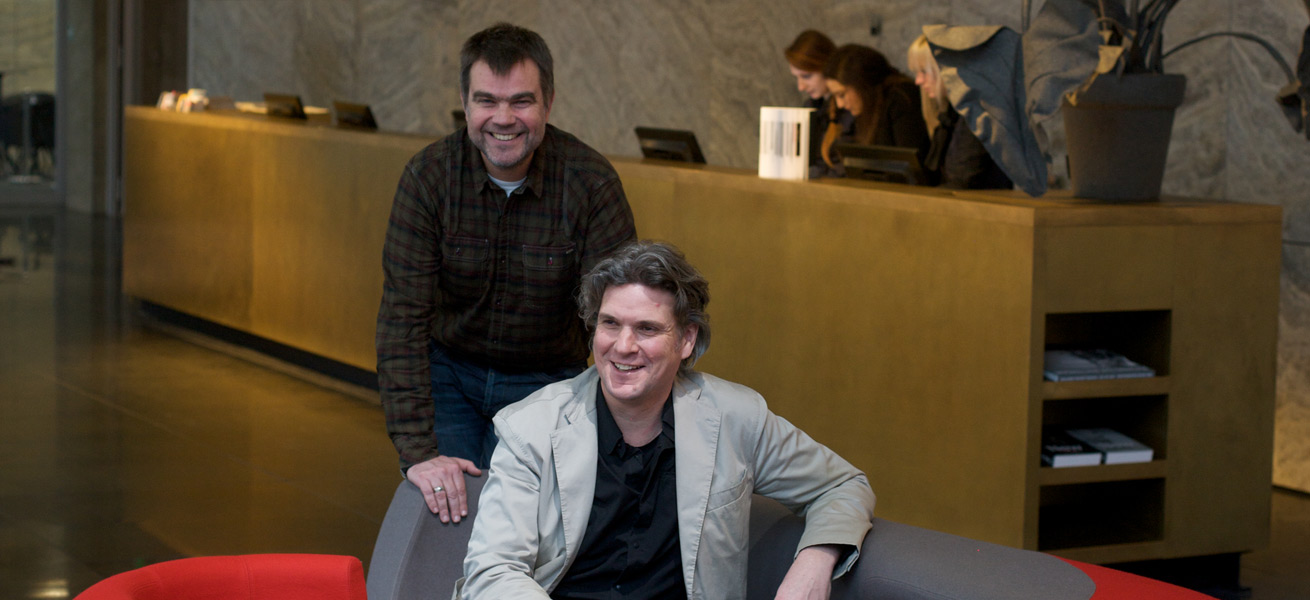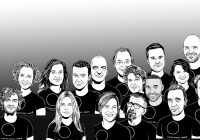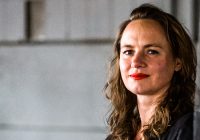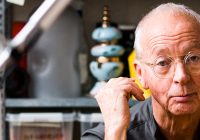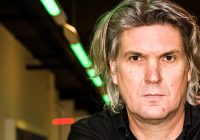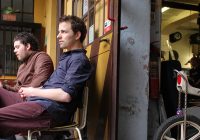Text by Annemiek van Grondel
Photo by Boudewijn Bollmann
Two Dutch bros, one Italian brand. Industrial designer Jacco Bregonje (49) and marketing consultant Tanno Bregonje (52) have plunged into a daring adventure by taking over Italian furniture brand Felicerossi, a move that requires talent, vision, and a great deal of guts and brotherly love. With the help of two partners, they are convinced they will be able to take this brand to the next level. ‘It is all about cultural change.’
Jacco Bregonje lives and breathes design. For twenty-two years he has lived in Italy, but it all started in the Netherlands, his mother country. After secondary school, Jacco was determined to study industrial design.
His father was his main inspiration. He worked for famous Dutch lighting brand Raak, which designed and furnished the showrooms of Artifort, among others. He fed his sons passionate stories about interior architecture and used to tell the boys: ‘Working for Artifort means you’ve really achieved something.’ The design virus took hold of Jacco and he applied for design studies in Eindhoven.
He was not admitted at first, so by way of a gap year he switched to architectural design studies in Maastricht. This proved very interesting, leading him to remain there for three years before finally going to the Design Academy in 1990. ‘I really wanted to do product design,’ Jacco explains from behind the Skype screen at his home in Angera, in the Varese district near Lago Maggiore, where he lives with his partner, Mirjam Breukers, fashion stylist for Missoni, among others, and their two children, Isis and Khodi. ‘In hindsight, I am glad to have been trained in architecture. Architects take a helicopter view of things before focussing, whereas an industrial designer immediately concentrates on the details. If you look at Italian design, for instance in the power years of the ‘80s, all big maestri in design were originally architects. Due to a lack of design schools in Italy, they studied architecture and then learned the design trade at a company in the industry. An industry, which that also welcomed foreigners.’
After finishing his studies, Jacco briefly worked at the Dutch studio of Paulus van Leeuwen, but decided to apply for an internship in Italy via an exchange program, just as his girlfriend, Mirjam, had done.
‘Emigration was an three-month adventure,’ he recalls. ‘I went to work at the Milan design studio of Maarten Kusters, who was also a lecturer at the Domus Academy, and I immersed myself in the local design scene. I learned a lot and had a great time. Then I got a call from a former teacher, Lou Beeren, who was design director at Philips, asking if I would be interested in working for Whirlpool Italy, in the Major Domestic Appliances department.’

Jacco Bregonje and Tanno Bregonje
Although Jacco was not really into working for multinationals – seen as quite uncool at the time – he seized the opportunity, thinking a year’s experience couldn’t do much harm. It turned out to be nine years. Within the first year, he was appointed senior design manager of the global microwave ovens division.
‘The division was ready for a new approach,’ he says. ‘Their focus was more on styling and they had to walk in step with the design of main products like washing machines and ovens. I introduced a new strategy and brought more dynamics into the organization. Product development for Whirlpool brought me into contact with Whirlpool’s subsidiary brands: Bauknecht, KitchenAid and Ignis. I learned to think in brand identities and platforms, to develop technological concepts and to translate these into brand identities. After the seven-year itch, I thought it was time for a change. There was some dissatisfaction: the industry was navel-gazing or imitating while I thought they should be doing more than mere styling. In design, you focus on differentiation, because your product has to compete with other brands on the store shelf. But after that, the product is principally in dialogue with the furniture in your home. What would happen if you consider a microwave as a piece of furniture?’
The next level
Jacco turned this idea into a plan and, to his great surprise, got the green light from the board to develop his concept. He invited four internationally renowned furniture designers – Konstantin Grcic, James Irvine, Christophe Pillet, and Riccardo Giovanetti – and four microwave designers, including himself, to come together and create a new vision on the principles of microwave design. Their designs were presented as eight small objects in large cubes at the Salone d’Onore at the Triennale in Milan in April 2000. The exhibition won an American IDEA Design Award, and the designs even made it to the Louvre and Centre Pompidou.
Jacco: ‘I realised that this was what I wanted to do – to live my personal vision and passion. I saw Grcic at work and got the urge to set up my own studio, designing for various clients. So I did, at Lago Maggiore. It is close to Malpensa Airport, and Milan only takes me about 40 minutes by car.’
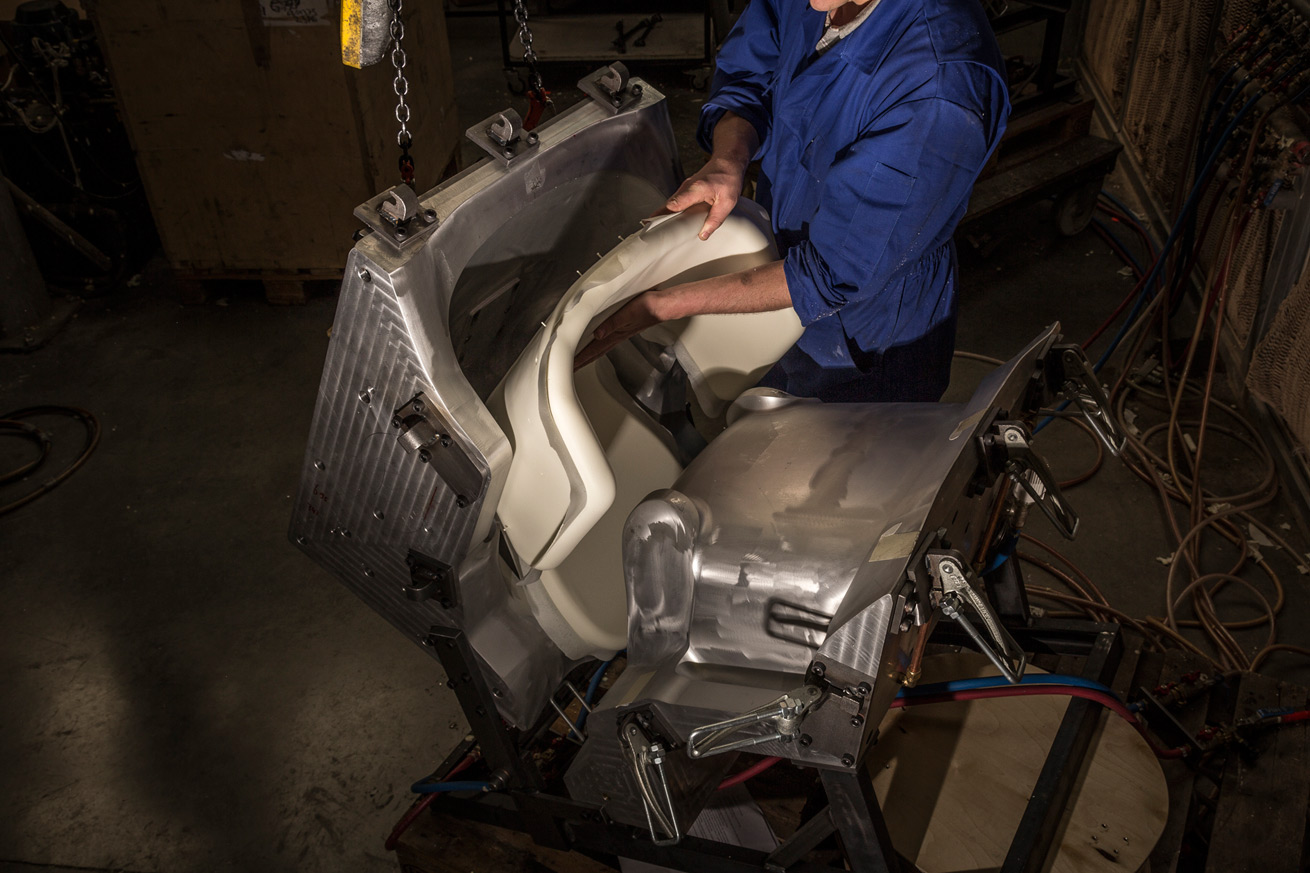
Mold Patch chair by Jacco Bregonje
One of his clients was furniture factory and brand Felicerossi, which was aiming for more outspoken collections. Jacco coordinated a furniture project called SOFA with various international designers. The project was very successful and paved the way to having his sofa prototype, Diva, taken into production. Luminaire, an exclusive design chain in the USA, immediately purchased the sofa. A derivative of the sofa, called Divina, was also taken into production by Felicerossi. The organically shaped armchair is a graphic statement: fluid in form and function with sculptural contours that refer to the reposing form of the human body. Divina hit the design charts in no time. It received the audience award at the Dutch Design Awards and was acquired by several museums, including the SFMOMA and the Stedelijk Museum Amsterdam. It became an instant design classic. Being Dutch, Jacco remained down to earth and worked on various design projects, such as the organically shaped Magnolia shell seat for Artifort. Last year, he spent a great deal of time in the Netherlands, working on the Patch project, in collaboration with Artifort and Missoni Home.
Working with Roberto Sartorio, owner of Felicerossi, resulted in tension about a possible succession of the business. A period of careful deliberation followed. It is no coincidence that Jacco’s professional life is divided into periods each spanning a decade. Almost 10 years at Whirlpool, 10 years as a freelance industrial designer… perhaps it was time for another ten-year plan. Change is something he embraces, although not in a calculated way. ‘It is a natural process,’ Jacco explains. ‘First you learn lots of new things, absorb them like a sponge, and then start a new chapter, applying your knowledge like squeezing the sponge. Then there is a need to absorb anew, and so on. Having to refresh is necessary, leaving your comfort zone to reinvent yourself. Time after time, I am driven by curiosity about what lies beyond the horizon. Every experience is enriching. All innovation is driven by curiosity.’

Divina chair by Jacco Bregonje
The future of the Felicerossi brand
Jacco decided to seek reinforcements in his vicinity. Not in Italy but in his immediate family, in the person of his brother, Tanno Bregonje (52), who happens to be an expert on change. Professionally, he helps large organizations to create cultural change.
After a period as a teacher, Tanno studied marketing in the 1980s. ‘In those years, companies had a strategic planning horizon of ten to fifteen years, while current planning is two, three years at most,’ Jacco’s brother comments from the Netherlands, via another Skype connection. ‘The life cycle of businesses and products is becoming shorter. In 1930, based on his long cycle theory, Taylor was focused on efficient planning; innovation wasn’t that necessary as it is nowadays. The present ambidextrous thinking generates both innovation and efficiency. I advise directors of multinationals like Unilever, AkzoNobel and Albert Heijn in change processes. For example, in 2006 I helped Microsoft to implement flexible working, inspired by Bill Gates’ The New World of Work, a white paper about how technology transforms the way we work. Thanks to technology-based innovation, we’re turning into a knowledge and service economy – smart workers supported by smart networks. Microsoft introduced that in the Netherlands. Their offices were refurbished and their approach to their employees changed, from being a manager in control to empowerment and trust. This calls for discussion and a great deal of mirroring and self-reflection.’
This is exactly what the Bregonje brothers had in mind for the future of the Felicerossi brand, after they decided to jump into the deep end. Jacco: ‘If an organization has a tough relationship with their employees, you won’t be inclined to take risks or seek innovation. Through new smart working, the office has been reinterpreted. The manager’s role changes from inspector to inspirer. Companies feel that the design of the office environment needs a breeze of fresh air. Because employees can work independent of time and location, the function of the office changes. You have to retain cohesion and create a place where your employees can share knowledge, become inspired and be passionate. The office and home market are shifting and converging. In the past, this was achieved by transferring furniture from the home segment to the office segment. You should respond to this. Take the Ear Chair, designed by Jurgen Bey for Interpolis, a Dutch insurance company. Vitra and other brands followed with sofas with high backrests. In an open area, you can create a protected space, a new concept in furniture. Gradually a new kind of conference furniture arises. There is clearly a market for that.’
The brothers foresee new opportunities. The new Felicerossi brand is also plugging ‘crossovers,’ a new archetype between the contract market and the home market. Tanno: ‘Bringing together home and office, that is one of the new themes at Felicerossi. Instead of only delivering furniture, we also supply concepts and solutions in which furniture plays an important role. I’m good at seeing trends and movements at a certain level of abstraction. Jacco is very good at translating these into something concrete.’
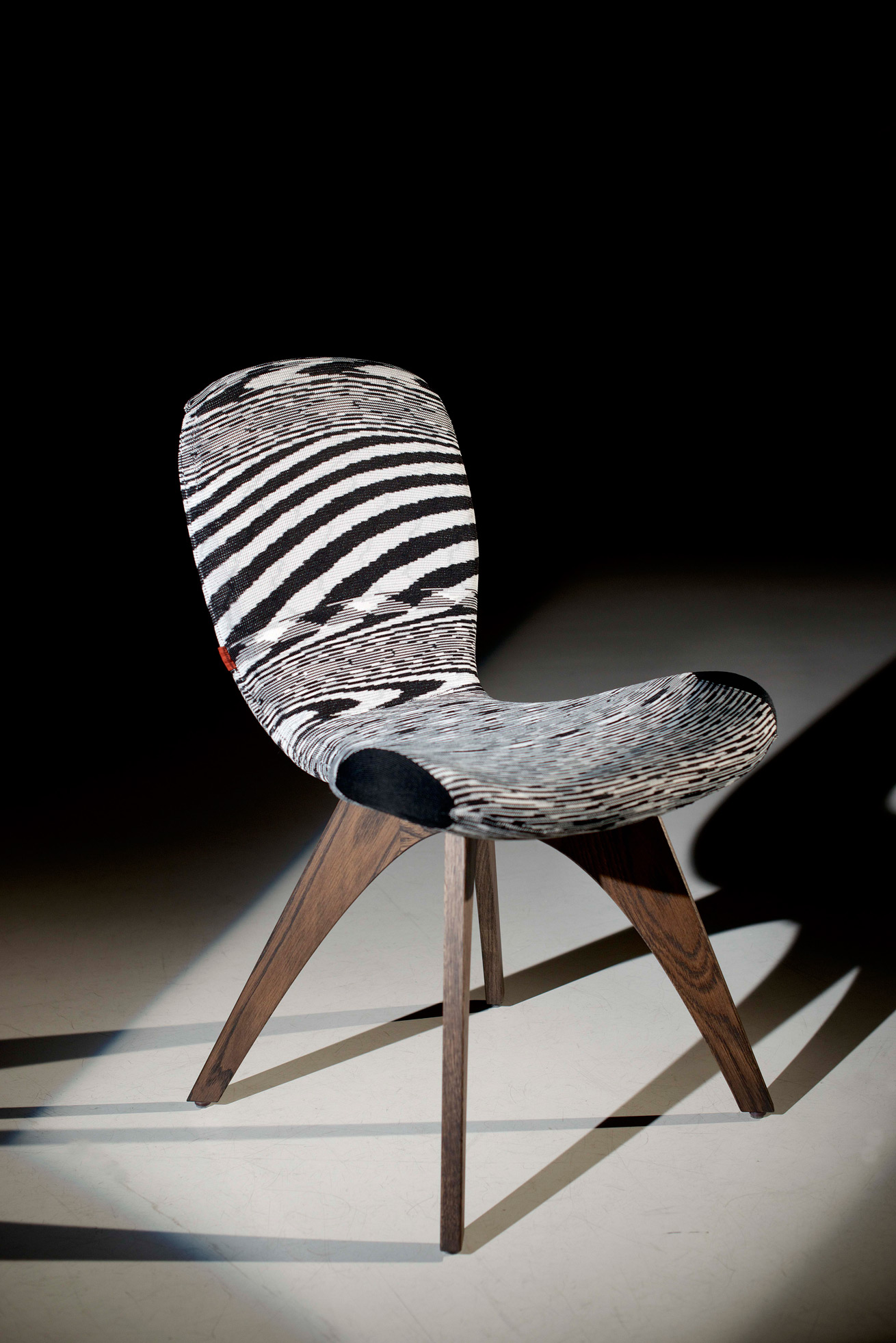
Patch Knit One with an innovative one-piece knitted cover for Artifort & MissoniHome
Building bridges
Jacco is Creative Design Director and Tanno is responsible for Felicerossi’s marketing and distribution. They have enlisted the help of Fokke van der Veer, former vice-president of Unilever Benelux, who is to become Chief of Operations responsible for the production, ecological consequences and physical distribution, and financial expert Hans Brassé, who will be controlling the finance department. The brothers emphasize that Felicerossi remains an Italian brand with an Italian identity and context. The ‘crossover products’ for the office of the future are to be developed in Italy. You will not find Felicerossi at home furniture dealers. Tanno: ‘We aren’t focussing on the home market but on the design of public spaces, offices, hospitals, airports lounges and so on. We are looking for a business model in the circular economy. Sustainability in materials and products is key. The first step is conquering Europe.’
This year, the new team will focus on the development of these products. The only visible transaction is the launch of a Divina for children at this Milan Design Week. Jacco: ‘A new generation of Felicerossi for a new generation of workers in the making.’ In 2015, Felicerossi will officially display new furniture at Milan’s Salone and World Expo.
Jacco is a genuine bridge-builder. ‘If different worlds intersect, you get innovation and a new kind of energy. Every company is on its own island and abides by its own culture. But when you cross them, like I did with Missoni Home (Southern Europe) and Artifort (Northern Europe), you can create something entirely new.’
The designer embodies the combination of Italian playful sophistication and Dutch common sense and practical thinking. He realizes the New World of Work is more topical in northern Europe and has yet to be incorporated into Italian society, where the work culture is more hierarchical. ‘I see that there is still much room for innovation in furniture, especially from the characteristics of Italian design,’ he believes. ‘People need solutions, emotion and experience. I think good design is based on innovative thinking in these areas.’
Tanno: ‘Felicerossi should excite: refinement from Italy combined with the sober functionality of Dutch design. That should work surprisingly well in a business environment. We are going to push the limits.’
This interview was published in Connecting the Dots #9 for the Milan Design Week 2014.
For entire magazine click here.

